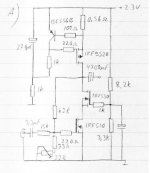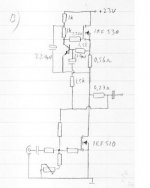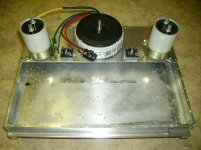Not that I´m not busy working on my Xsoz, I felt that I needed a little side project too
I have a pair of bookshelf speakers with TB 3" and Peerless 5-1/4" drivers that sounds quite good, actually so good that they deserve biamping with class A amps.
Nothing too serious though, just a handful of components assembled on veroboards an then mounted on a big heatsink that I have leftover from the Xsoz project.
After searcing this forum I sort of fell for the Baby Zen, a small "inofficial" Zen amp with low power mosfets and lower rail voltage/bias current.
A version with dynamic current source is also floating around somewhere.
On top of all this I´m curious about cascoded gain stages, I´ve read alot about it but never tried it myself.
After some cut n´paste engineering I came up with these two circuits, A) for the TB fullrange drivers and B) for the Peerless woofers.
I have a pair of bookshelf speakers with TB 3" and Peerless 5-1/4" drivers that sounds quite good, actually so good that they deserve biamping with class A amps.
Nothing too serious though, just a handful of components assembled on veroboards an then mounted on a big heatsink that I have leftover from the Xsoz project.
After searcing this forum I sort of fell for the Baby Zen, a small "inofficial" Zen amp with low power mosfets and lower rail voltage/bias current.
A version with dynamic current source is also floating around somewhere.
On top of all this I´m curious about cascoded gain stages, I´ve read alot about it but never tried it myself.
After some cut n´paste engineering I came up with these two circuits, A) for the TB fullrange drivers and B) for the Peerless woofers.
Attachments
Circuit A) is cascoded and has a static CCS, B) is not cascoded but has a dynamic, Aleph-type CCS. I guess any combination of cascodes and CCS`s is possible, this is only my attempt to optimize for the different frequency ranges in my biamped system.
I don´t quite understand, I look at the schematic and I see a straight line between the drain of the IRF510 and the source of the IRF530. The gate of the `530 is connected to a voltage divider for about 6,5V bias and has, as far as I can see, nothing to do with the drain of the `510.
Just for clarity: IRF510 is the input mosfet and the IRF530 is the cascode transistor which keeps the input transistors drain at a constant 2,5V or so.
In circuite A the drain of irf510 is only connected to the gate of irf530. I don`t think you have any current path with this connection.
I don´t quite understand, I look at the schematic and I see a straight line between the drain of the IRF510 and the source of the IRF530. The gate of the `530 is connected to a voltage divider for about 6,5V bias and has, as far as I can see, nothing to do with the drain of the `510.
Just for clarity: IRF510 is the input mosfet and the IRF530 is the cascode transistor which keeps the input transistors drain at a constant 2,5V or so.
B) is not cascoded but has a dynamic, Aleph-type CCS.
Ah, yes... there's the little Aleph bugger. Why not run B with the addition of a cascoded topology--sort of like blending the two layouts. BTW, I really like the simple way you executed your design.
John
edit: how come the word bug-ger is censored?
Also, Fuling, can draw your prints a bit larger? I can't make out all the values. I'm saving your drawings anyway.
Thanks.
althought is biased,does not see any AC modulated signal to it's gate...
A modulated cascode would of course be even better, but since I don´t have a source resistor there is no place to get that modulation signal from. At least not as far as I can see.
A "static" cascode should be a significant improvement over the basic circuit anyway, at least I hope so.
Why not run B with the addition of a cascoded topology--sort of like blending the two layouts.
Might be a great idea, but somehow I have this prejudice that the active CCS is inferior to a regular one when it comes to microdynamics and stuff. I might be totally wrong here though!
The reason I´ll use it in the bass amps is that I want to have better current capability to drive the woofers.
This whole reasoning might sound silly considering that we´re talking 5W amps that will drive 3" and 5" speakers, but for me this hobby is all about experimenting and having fun.
When finished I will of course try both topologies with different speakers (including my main speakers, not the tangbands) to find out if one of them is significantly better than the other.
I can draw better schematics tomorrow, I did these ones in a hurry at work.
By the way, I´ve spent a couple of hours doing some metalwork tonight and now the PSU is almost finished and attached to the heatsink. The heatsink has about a million M3 tapped holes so it´s kind of building Lego or something
The Fets and everything else should arrive on Tuesday or Wednesday so this shouldn´t take too long to finish.
I see you have 23 VDC supply.
Is this from a 18VAC trafo?
What type of transformer and VA rating?
Maybe you use a 2x18VAC,
with each channel using only one of windings?
Tell a bit more of your idea for the power supply.
This is an important part of any power amplifier,
as you know.
How much is the bias idle current for each baby-zen?
In case you haven't already mentioned.
lineup
Is this from a 18VAC trafo?
What type of transformer and VA rating?
Maybe you use a 2x18VAC,
with each channel using only one of windings?
Tell a bit more of your idea for the power supply.
This is an important part of any power amplifier,
as you know.
How much is the bias idle current for each baby-zen?
In case you haven't already mentioned.
lineup
Lineup: 2x20V 200VA toroid transformer, each winding feeds a bridge rectifier, a 15000uF 40V cap and a simple capacitance multiplier. If I had just a couple of volts more available I´d use CLC-filters before the C-multiplier to get extra quiet PSU´s, I use that configuration in another amp and the background is pitch black!
Spasticteapot: Yes, but not today. I´m on my way to work now and will be stuck there the next 29 hours or so...
Spasticteapot: Yes, but not today. I´m on my way to work now and will be stuck there the next 29 hours or so...

Fuling said:The PSU:
Very Solid and Good supply!
Some time maybe, I will get myself to buy such good stuff
to my amplifiers.
Sure is what any power amplifier should have - for best results.
Very Nice, Fuling
Thank you!
It´mostly buy used and surplus parts, that´s the only way for me to afford building class A amps all the time!
Since I´m mostly into trying out new circuits and having fun I rather build five different amps with cheap components (not everywhere though, I tend to use good caps for example) than one super amp for the same money.
Sometimes when I´ve made some prototype that sounds really good I build an improved version with better components later, but most of my projects are quite temporary.
Anyway, I noticed that the caps are assembled in opposite directions, please remind me to turn one of them 180 degrees before I start connecting things
I got the missing parts for my Xsoz today so this project will be put aside for a (short) while, I also forgot to order output connectors so I´ll have to wait for them to arrive.
I can probably populate the veroboards within a couple of days but the remaining mechanical work might take longer.
It´mostly buy used and surplus parts, that´s the only way for me to afford building class A amps all the time!
Since I´m mostly into trying out new circuits and having fun I rather build five different amps with cheap components (not everywhere though, I tend to use good caps for example) than one super amp for the same money.
Sometimes when I´ve made some prototype that sounds really good I build an improved version with better components later, but most of my projects are quite temporary.
Anyway, I noticed that the caps are assembled in opposite directions, please remind me to turn one of them 180 degrees before I start connecting things
I got the missing parts for my Xsoz today so this project will be put aside for a (short) while, I also forgot to order output connectors so I´ll have to wait for them to arrive.
I can probably populate the veroboards within a couple of days but the remaining mechanical work might take longer.
I can't wait to hear your impressions on its sound qualities.
I had a first listening session with this amp today.
Since my active crossover needs some modifications before it can drive the Baby Zens and my Tangband speakers, I listened to each pair och amps with my FE167E speakers and an input buffer.
Impressions: Both sets of amps sounded quite good, but the HF amps definitely had better highs than the LF amps (big surprise, huh?
I believe I can thank the cascoded gainstage for this, the treble sounded very clear compared to what came out of the more aggressive bass amps.
This was only a first impression based on one hour (or so) of listening to each pair.
I´ll give the amps some time to break in and then report further, meanwhile I will also mod the active XO so I can try the amp out with the speakers it´s intended to drive.
Conclusion so far: Cascoding is the way to go!!
This is definitely not my last amp with a single cascoded gainstage!
Ohhhhh....
An amp for different applications in the audio spectrum...
I totally missed that point. Now, you're going to have to give me many more details. For instance, does the bass amp not deliver the highs intentionally (i.e. designed for bass applications only); with the aleph current source connection, it should have more power, correct? How does the cascode treble amp sound doing full spectrum? I want all the juicy detail--all in due time, of course.
For instance, does the bass amp not deliver the highs intentionally (i.e. designed for bass applications only); with the aleph current source connection, it should have more power, correct? How does the cascode treble amp sound doing full spectrum? I want all the juicy detail--all in due time, of course.
My hat's off to you fuling, excellent job in audio exploration!
John
btw: can you rewrite those component values in larger print?
An amp for different applications in the audio spectrum...
I totally missed that point. Now, you're going to have to give me many more details.
My hat's off to you fuling, excellent job in audio exploration!
John
btw: can you rewrite those component values in larger print?
Yup, both amps works fullrange but they are optimized for different frequency ranges. The cascodes are there to clean up the highs in the HF amps and the Aleph CCS´s are meant to deliver extra current to the woofers.
If I had to choose one of the amps for fullrange use it would definitely be the cascoded one with static CCS.
I can post better schematics tomorrow night.
If I had to choose one of the amps for fullrange use it would definitely be the cascoded one with static CCS.
I can post better schematics tomorrow night.
- Status
- This old topic is closed. If you want to reopen this topic, contact a moderator using the "Report Post" button.
- Home
- Amplifiers
- Pass Labs
- Baby Zen for biamping





 I can't wait to hear your impressions on its sound qualities.
I can't wait to hear your impressions on its sound qualities.